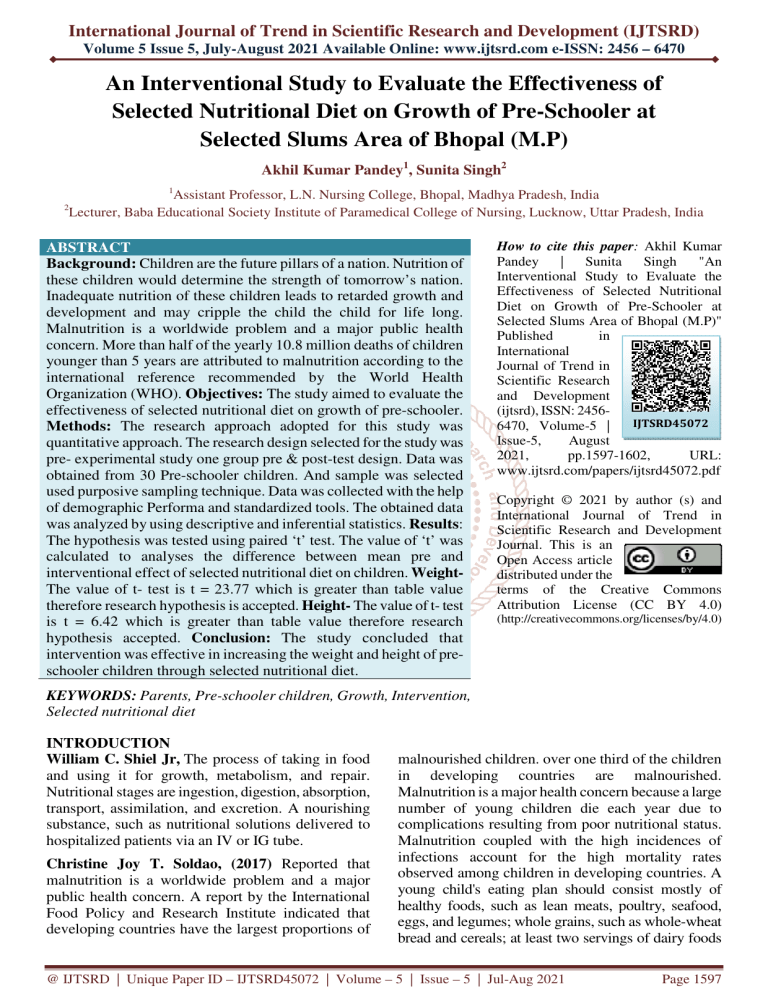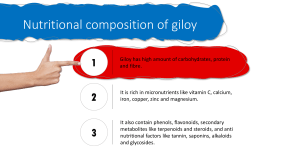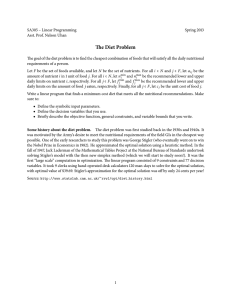
International Journal of Trend in Scientific Research and Development (IJTSRD)
Volume 5 Issue 5, July-August 2021 Available Online: www.ijtsrd.com e-ISSN: 2456 – 6470
An Interventional Study to Evaluate the Effectiveness of
Selected Nutritional Diet on Growth of Pre-Schooler at
Selected Slums Area of Bhopal (M.P)
Akhil Kumar Pandey1, Sunita Singh2
1
2
Assistant Professor, L.N. Nursing College, Bhopal, Madhya Pradesh, India
Lecturer, Baba Educational Society Institute of Paramedical College of Nursing, Lucknow, Uttar Pradesh, India
ABSTRACT
Background: Children are the future pillars of a nation. Nutrition of
these children would determine the strength of tomorrow’s nation.
Inadequate nutrition of these children leads to retarded growth and
development and may cripple the child the child for life long.
Malnutrition is a worldwide problem and a major public health
concern. More than half of the yearly 10.8 million deaths of children
younger than 5 years are attributed to malnutrition according to the
international reference recommended by the World Health
Organization (WHO). Objectives: The study aimed to evaluate the
effectiveness of selected nutritional diet on growth of pre-schooler.
Methods: The research approach adopted for this study was
quantitative approach. The research design selected for the study was
pre- experimental study one group pre & post-test design. Data was
obtained from 30 Pre-schooler children. And sample was selected
used purposive sampling technique. Data was collected with the help
of demographic Performa and standardized tools. The obtained data
was analyzed by using descriptive and inferential statistics. Results:
The hypothesis was tested using paired ‘t’ test. The value of ‘t’ was
calculated to analyses the difference between mean pre and
interventional effect of selected nutritional diet on children. WeightThe value of t- test is t = 23.77 which is greater than table value
therefore research hypothesis is accepted. Height- The value of t- test
is t = 6.42 which is greater than table value therefore research
hypothesis accepted. Conclusion: The study concluded that
intervention was effective in increasing the weight and height of preschooler children through selected nutritional diet.
How to cite this paper: Akhil Kumar
Pandey
|
Sunita
Singh
"An
Interventional Study to Evaluate the
Effectiveness of Selected Nutritional
Diet on Growth of Pre-Schooler at
Selected Slums Area of Bhopal (M.P)"
Published
in
International
Journal of Trend in
Scientific Research
and Development
(ijtsrd), ISSN: 2456IJTSRD45072
6470, Volume-5 |
Issue-5,
August
2021,
pp.1597-1602,
URL:
www.ijtsrd.com/papers/ijtsrd45072.pdf
Copyright © 2021 by author (s) and
International Journal of Trend in
Scientific Research and Development
Journal. This is an
Open Access article
distributed under the
terms of the Creative Commons
Attribution License (CC BY 4.0)
(http://creativecommons.org/licenses/by/4.0)
KEYWORDS: Parents, Pre-schooler children, Growth, Intervention,
Selected nutritional diet
INTRODUCTION
William C. Shiel Jr, The process of taking in food
and using it for growth, metabolism, and repair.
Nutritional stages are ingestion, digestion, absorption,
transport, assimilation, and excretion. A nourishing
substance, such as nutritional solutions delivered to
hospitalized patients via an IV or IG tube.
Christine Joy T. Soldao, (2017) Reported that
malnutrition is a worldwide problem and a major
public health concern. A report by the International
Food Policy and Research Institute indicated that
developing countries have the largest proportions of
malnourished children. over one third of the children
in developing countries are malnourished.
Malnutrition is a major health concern because a large
number of young children die each year due to
complications resulting from poor nutritional status.
Malnutrition coupled with the high incidences of
infections account for the high mortality rates
observed among children in developing countries. A
young child's eating plan should consist mostly of
healthy foods, such as lean meats, poultry, seafood,
eggs, and legumes; whole grains, such as whole-wheat
bread and cereals; at least two servings of dairy foods
@ IJTSRD | Unique Paper ID – IJTSRD45072 | Volume – 5 | Issue – 5 | Jul-Aug 2021
Page 1597
International Journal of Trend in Scientific Research and Development @ www.ijtsrd.com eISSN: 2456-6470
daily; and fresh or lightly processed fruits and
vegetables.
Preschool-age children are still developing their eating
habits and need encouragement to eat healthy meals
and snacks. These children are eager to learn. They
will often imitate eating behaviors of adults. They
need supervision at mealtime as they are still working
on chewing and swallowing skills.
Elsevier,(2018)Good nutrition in early childhood is
essential to ensure children reach their growth and
developmental potential. Furthermore, dietary health
behaviours and food preferences are learnt early and
carry through into adulthood. In all ages, and
increasingly in younger populations, poor food
choices and overconsumption are associated with a
higher risk of developing obesity. Excessive weight
developed in early childhood is particularly
problematic as it is associated with an increased risk
of developing physical, social and psychological
conditions and earlier onset of non-communicable
diseases (NCD). Contrary to popular belief, many
children carrying extra weight do not outgrow it and
childhood-onset obesity is particularly difficult to
address in later life. As such, concern for children’s
health, and escalating rates of NCD, have prompted
the prioritization of healthy diets for young children
globally.
Pre-schooler children need to develop healthy eating
and physical activity habits early on. Children pattern
habits after parents and caregivers. Pre-schoolers
quickly grow and change physically, mentally, and
socially. Pre-schoolers need healthy food to meet
their growth and developmental needs. These can best
be met by following national and/or local food guide
recommendations for ages 2-5. Meal and snack times
teach sharing and socializing skills. Small children
have small stomachs and get full quickly. They need
child-sized servings for meals and snacks that respect
local traditions and customs.
Need For the Study:
In a developing country, like India there are many
constraints to better living and adequate nutrition.
Lack of awareness about the dietary requirements and
nutritive value of different food is the main cause for
growth retardation among pre-school children.
Over all nearly half of the young children in India are
underweight (46%) and one in six children were
wasted (16%).The levels of under nutrition are much
higher in rural areas than in urban areas .Under
nutrition is most prominent in the states of Bihar,
Uttar Pradesh, Madhya Pradesh, Rajasthan. About half
the children are stunted in Assam and Haryana. In the
rural areas. 20.3% of children were severely
malnourished; 30.2% were moderately nourished;
50.5% were malnourished (moderate and severe). In
the urban areas, 12% of the children were severely
malnourished and 27% were moderately malnourished
and 39% were malnourished (moderate and severe).
Malnutrition levels were much higher among tribal
children in rural areas. In Madhya pradesh the
incidence is as high as 73.6%.
The final report of this study revealed that nutritional
awareness had increased among mothers and the
incidence of malnutrition and growth retardation
dropped from 6.5% to1.8% as measured against the
weight for height.
PROBLEM STATEMENT:
“An interventional study to evaluate the effectiveness
of selected nutritional diet on growth of pre-schooler
at selected slums area of Bhopal M.P.”
OBJECTIVES:
To assess the pre-interventional growth of preschooler.
To assess the effectiveness of selected nutritional
diet on growth of pre-schooler.
To find out the difference between pre and post
interventional growth of pre-schooler.
To find out the association between weight and
height of the pre-schooler with selected
demographic variables.
HYPOTHESIS:
H1: There is a significant difference between the postinterventional and pre-interventional mean score
regarding growth of pre-schooler.
H2: There is a significant association between preinterventional mean of weight with selected
demographic variables.
H3: There is a significant association between preinterventional mean of height with selected
demographic variables.
OPERATIONAL DEFINITIONS:
Evaluate: It is a measurement of growth of preschooler children
Effectiveness: It refers to outcome of the growth in
term of height and weight among pre-schooler
children after the intervention regarding selected
nutritional diet pattern.
Intervention: It means action taken or interventing to
improve the growth of pre-schooler children by in
calculating the selected nutritional diet among preschooler.
Growth: It is a quantitative changes that make some
varies in term of height and weight intervention period
of the pre-schooler at prescribed.
@ IJTSRD | Unique Paper ID – IJTSRD45072 | Volume – 5 | Issue – 5 | Jul-Aug 2021
Page 1598
International Journal of Trend in Scientific Research and Development @ www.ijtsrd.com eISSN: 2456-6470
Nutrition diet: It means protein rich food that
researcher is provide to measure the growth of preschooler children, eg: sprouted grams, butter and milk,
egg (optional).
Description of the tool:
PROTOCOL OF SELECTED NUTRITIONAL
DIETAccording to- National health portal of India
Pre-schooler: In this study preschooler denotes the
children between the age group of 3-6years at selected
slums area, Bhopal.
Energy rich foods (Carbohydrates and fats)-whole
grain cereals, millets, vegetable oils, ghee, nuts and
oilseeds and sugars.
MATERIAL AND METHODS:
Research approach:
Quantitative with evaluative approach.
Body building foods (Proteins)- Pulses, nuts and
oilseeds, milk and milk products, meat, fish, poultry.
Research design:
Pre-Experimental.
Variables:
Independent variables: Assessment of
intervention nutritional dietary pattern on the
growth among pre-school children.
Dependent variables: Growth of pre-schooler in
term of height and weight.
Demographic variables: Such as Age, sex, type
of family, Occupation of the parents, Education of
the parents.
Research setting:
The study was conducted in Slum Area of Bhopal
district.
Population: Pre-schooler children at Selected Slum
Area of Bhopal district.
Sample:
Pre-schooler children at slums area of Bhopal.
Sample size: 30 Pre-schooler children.
Sample techniques:
Purposive sampling technique
Criteria for sample selection:
Inclusion criteria:
1. Who were in pre-school age in Selected Slum
Area.
2. Who were available at the time of data collection.
3. Who were willing to participate.
Exclusion criteria:
1. Who were not willing to participate.
2. Who were not available at the time of study.
Tool and method of data collection:
Methods of data collection include selection and
development of tool, testing of tool for validity and
reliability and pre-testing by administering on few
samples and data collection procedure.
Protective foods (Vitamins and minerals) - Green
leafy vegetables, other vegetables, fruits, eggs, milk
and milk products and flesh foods.
PROJECTED OUTCOME:
The finding will give on insight into the assessment
of interventional nutritional dietary pattern on growth
of pre-schooler children.
Data collection procedure-:
The investigator obtained written permission from
the Selected slum area Bhopal.
The purpose of the study was explained to them
and confidentiality was assured to all the
respondents. The children were selected by
convenient sampling technique.
The pre-assessment of height and weight done for
10 days on a total of 30 respondents following the
administration of intervention diet for 10 days
along with assessment of height and weight then
assess the height and weight post-intervention for
10 days.
Ethical consideration:
Formal permission was obtained from the
Banjari and Fanda slums areas, Chief medical
officer, Child development programme officer,
Bhopal, Block medical officer.
After explaining the purpose of the study written
consent will be taken from the mother of
preschooler children at Banjari and Fanda slums
area.
Plan for data analysis:
The data will be analyzed using both descriptive and
inferential statistics.
Demographic variables &knowledge scores
would be analyzed by usingmean, mean
percentage, mean difference and standard
deviation.
‘t-test’ will be used for effectiveness of
assessment of interventional diet on growth of
pre-schooler children.
Chi squire test used for finding the association
between preinterventional score with selected
demographic variables.
@ IJTSRD | Unique Paper ID – IJTSRD45072 | Volume – 5 | Issue – 5 | Jul-Aug 2021
Page 1599
International Journal of Trend in Scientific Research and Development @ www.ijtsrd.com eISSN: 2456-6470
RESULTS:
Table No.1 Frequency and percentage distribution of pre-schooler children based on demographic
variable.
S/N
Demographic Variable
Frequency Percentage
4
21
70
1 Age
5
9
30
Male
16
53.33
2 Sex
Female
14
46.7
Joint Family
17
56.7
3 Type of family
Nuclear Family
13
43.33
Extended Family
0
0
Non- Family
12
40
Primary
6
20
High School
3
10
4 Parent education
Higher Secondary
6
20
Graduate
3
10
Post Graduate
0
0
Labour
18
60
Private job
8
26.7
5 Parent occupation
Government job
0
0
Business
4
13.33
Table 1. Described about the frequency, percentage distribution of demographic variable. Distribution of the
subject by age revealed that majority of the subject, i.e. higher (70%) belongs to 4 years followed by (30%) of
pre-schooler in the age group of 5 year. With regard to sex higher of pre-schooler (53.33%) are male and
(46.7%) are female. With regard to type of family that higher of pre-schooler belong to (56.7%) joint family and
(43.33%) belongs to nuclear family. With regard to parent education that higher of Parents (40%) non-formal,
(20%) of primary and higher secondary, (10%) of high school and (10%) of graduate. With regard to parent
occupation higher of Parents are (60%) labour, (26.7%) having Private job and (13.33%) having self business.
Table 2: Analysis of effectiveness of selected nutritional diet in weight
N=30
Mean score Pre-interventional mean Post Interventional mean t-test
Weight
13.66
13.90
23.77
This shows that intervention mean is greater than pre intervention mean. There is effectiveness of selected
nutritional diet.
For proved it, paired T-test done. The result of T-test shows that obtained value is 23.77 which is greater than
table value is 2.05. so hypothesis H1 is accepted.
Table 3: Analysis of effectiveness of selected nutritional diet in height
N=30
Mean score Pre-interventional mean Post-interventional mean t- test
Height
102.88
103.02
6.42
This shows that post intervention mean is greater than pre intervention mean. There is effectiveness of selected
nutritional diet.
For proved it, paired T-test done. The result of T-test shows that obtained value is 6.42 which is greater than
table value is 2.05. so hypothesis H1 is accepted.
@ IJTSRD | Unique Paper ID – IJTSRD45072 | Volume – 5 | Issue – 5 | Jul-Aug 2021
Page 1600
International Journal of Trend in Scientific Research and Development @ www.ijtsrd.com eISSN: 2456-6470
Table 4.Chi-square Test showing the association between pre-interventional mean of weight with
selected demographic variables
Selected
Selected
nutritional
Table Obtained
demographic
Category
Df
Significance
diet mean
value
value
variables
≤
≥
4
15
6
Age of
1
3.84
6.19
S
children
5
2
7
Male
10
6
Sex
1
3.84
0.45
NS
Female
7
7
Non formal
5
7
Primary (1-4)
4
2
2
1
Education of High school(7-10)
5
11.07
1.77
NS
parents
Higher secondary(11-12)
4
2
Graduate
2
1
Post graduate
0
0
Labour
10
8
5
3
Occupation of Private job
3
7.82
0.16
NS
parents
Govt. job
0
0
self Business
2
2
Nuclear
10
7
Type of
2
5.99
0.09
NS
Joint
7
6
family
Extended
0
0
NS= Not significant S= Significant
The table No 4.shows that there is significant association between pre-interventional score of weight and
selected socio-demographic variables of children such as Age of child, and no significant association between
pre-interventional score of weight and selected socio-demographic variables of children such as Sex, Type of
family, Education of parents, Occupation of parents. So majority of demographic variable had no significant
association hence the research hypotheses H2 is not accepted.
Table 5.Chi-square Test showing the association between pre-interventional mean of height with
selected demographic variables
Selected
Selected
nutritional
Table Obtained
demographic
Category
Df
Significance
diet mean
value
value
variables
≤
≥
4
16
5
Age of children
1
3.84
7.63
S
5
2
7
Male
8
8
Sex
1
3.84
1.41
NS
Female
10
4
Non formal
7
5
Primary (1-4)
3
3
High school(7-10)
3
0
Education of
5
11.07
2.56
NS
parents
Higher secondary(11-12)
3
3
Graduate
2
1
Post graduate
0
0
Labour
11
7
Private job
5
3
Occupation of
3
7.82
0.18
NS
parents
Govt. job
0
0
self Business
2
2
Nuclear
10
7
Type of family
Joint
8
5
2
5.99
0.02
NS
Extended
0
0
NS= Not significant S= Significant
@ IJTSRD | Unique Paper ID – IJTSRD45072 | Volume – 5 | Issue – 5 | Jul-Aug 2021
Page 1601
International Journal of Trend in Scientific Research and Development @ www.ijtsrd.com eISSN: 2456-6470
Table No 5-Shows that there is significant association between pre-interventional score of height and selected
socio-demographic variables of children such as Age of child, and no significant association between preinterventional score of height and selected socio-demographic variables of children such as Sex, Type of family,
Education of parents, Occupation of parents. So majority of demographic variable had no significant association
hence research hypotheses H3 is not accepted.
DISCUSSION:
The result of T-test shows that obtained value is
23.77 which is greater than table value is 2.05. so
hypothesis H1 is accepted.
Majority of demographic variable had no
significant association hence the research
hypotheses H2 & H3 is not accepted.
Conclusion: Intervention was effective in increasing
the weight and height of pre-schooler children
through selected nutritional diet.
Recommendations:
1. Provide nutritional training for the teachers about
good nutrition to the preschool children.
2. Provide dietary services to recognize the
preschool malnutrition disease and put the
treatment healthy programs for them.
3. Apply nutritional programs to the fathers and
mothers about the recommended daily allowances
and good healthy nutrition to the preschool
children.
4. Preventing buy any candy foods like gas drinks or
chips in the Kindergarten.
5. Making nutritional programs to the teachers about
dental care in the preschool children.
6. Integrate nutritional courses to the children in the
kindergarten to learning good food habits and
practices.
Conflict of interest: No
Financial support: Self
REFERENCE:
[1] Swaminathan. M, Advanced Text Book of
Food and Nutrition. 2nd Edition; Published by
Bangalore Printing and Co limited: page no
230, 540
[2] Kumar. A, Jai A. K: Mittal P. et. al, “Weight
and Height of 5-10 yrs, old children of upper
socio-economic status’’ Indian paediatrics.
1990;27(8);835
[3] Pari R, Chawla P and Menta S, “Retention of
nutrition and health knowledge and proteins –
After an in-service training programme”, Indian
journal of nutrition and Dietetics. 1994; 21(11);
437-443.
[4] Shanti Ghosh, Nutrition and Child care, 2nd
Edition, Jaypee brothers, 178.
[5] Malnutrition
in
India’’.
http:/www.Nutritionorg/misc/terms.shtml.
[6] Malekafzali H. Community based nutritional
intervention for reducing malnutrition among
children under five years of age in the Islamic
republic of iran. East Mediters Health Journal
2000, Mar-May:6(2-3)238-45.
[7] Sadka, L. Nancy, “Integrated child
development services” New Delhi; published
by UNICEF. 1984; 8-12pp.
[8] WHO Report, “Life in the 21st Century – a
vision forals’’ WHO Geneva, 1998.
[9] Getanesh T. Protein Energy Malnutrition in
urban children Prevalence and Determinants.
Ethiop Medical Journal 1998; 36(3); 153-156.
[10] Rikimaru T, Risk Factors for the prevalence of
Malnutrition among children science vitaminol
(Tokyo). 1998 June; 44(3); 391-407.
@ IJTSRD | Unique Paper ID – IJTSRD45072 | Volume – 5 | Issue – 5 | Jul-Aug 2021
Page 1602




